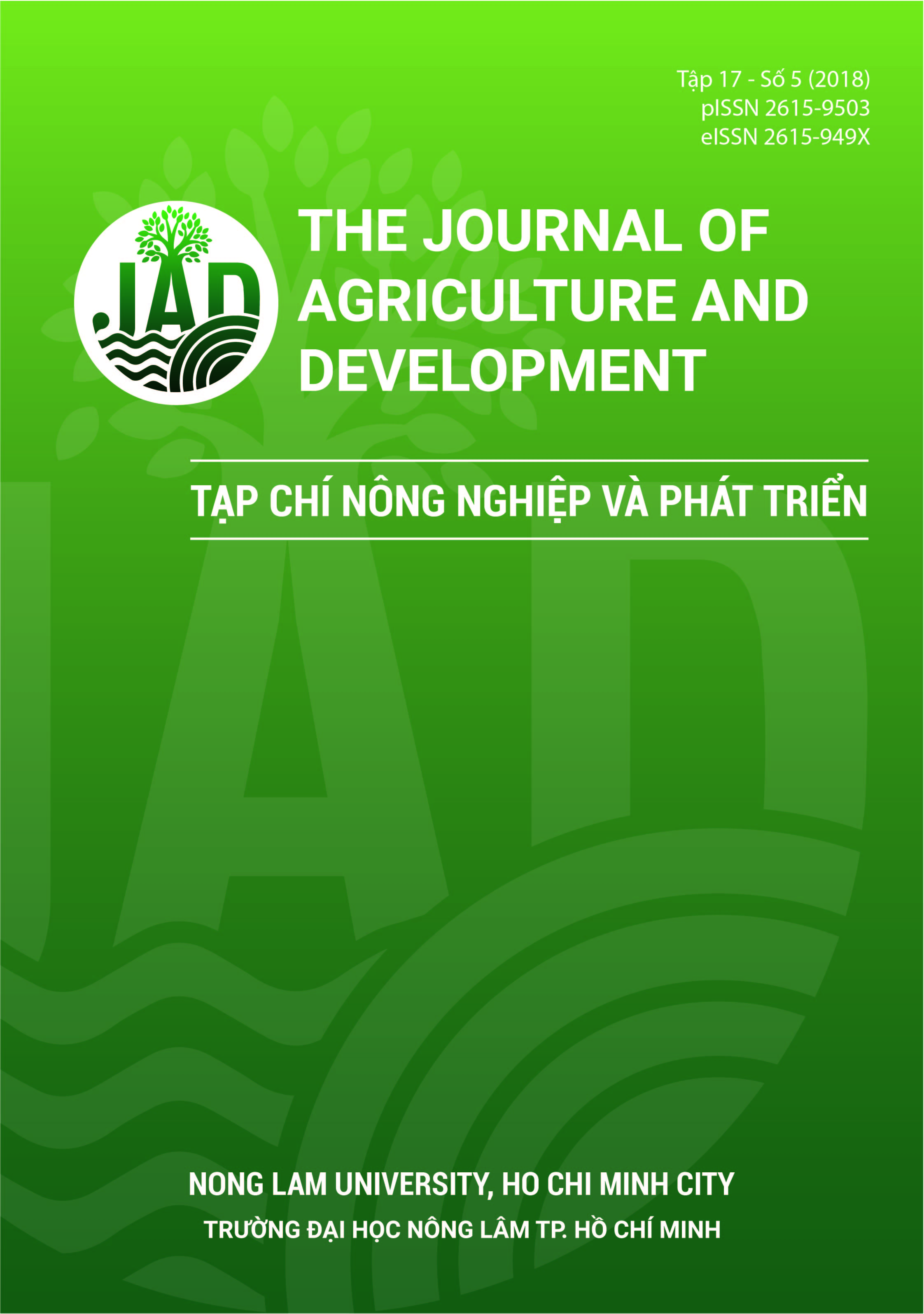Phân tách thành phần hoạt chất một số cây dược liệu bằng phương pháp sắc ký bản mỏng
Main Article Content
Tóm tắt
Phân tách và xác định một số hoạt chất có tác động dược học từ chiết xuất của một số cây dược liệu (chanh, sim và trà xanh) bằng kỹ thuật sắc ký bản mỏng (Thin Layer Chromatography, TLC) cho thấy hiệu suất khi thu hồi cao từ lá chanh, lá sim và lá trà xanh ở mức 1,5%, 5,62% và 10,4%. Hệ dung môi toluen: ethyl acetate (93:7) (v:v), phù hợp để phân tách các hoạt chất trong cao thô chiết xuất từ lá chanh và lá sim; hệ dung môi chloroform: ethyl acetate: acid formic (5:4:1) (v:v:v) phù hợp trong phân tách hoạt chất trong cao thô chiết xuất từ lá trà xanh. Ngoài ra, cô quay chân không có thể làm thay đổi số lượng các hoạt chất trong thành phần dịch chiết lá chanh. Sắc ký đồ của dịch chiết lá chanh, sim và trà xanh cho kết quả tương đương khi phát hiện trên bản mỏng sắc ký bằng buồng soi UV (λ = 254 nm) và thuốc thử 0,1 g vanillin trong 28 mL methanol: 1 mL sulfuric acid. Ba hoạt chất có đặc tính dược học bao gồm citral (chanh), rhdomyrtone (sim) và catechin hydrate (trà xanh) có trong thành phần tách chiết của 3 dược liệu có giới hạn phát hiện (LOD) ở mức 195 ng/vệt, 321,5 ng/vệt và 625 ng/vệt sắc ký đồ.
Article Details
Tài liệu tham khảo
Asadhawut, H. (2010). Chemical Constituents from Rhodomyrtus tomentosa (Aiton) Hassk and antibacterial activity (Unpublished doctoral dissertation). Prince of Songkla University, Hat Yai, Thailand.
Ashray, G. (2012). Extraction, purification, identification and estimation of catechins from Camellia sinensis (Unpublished bachelor’s thesis). Institute of Himalayan Bioresource Technology (IHBT), Palampur, India.
Auemphon, M., Shiv, S., Usa, C., & Voravuthikunchai, S. P. (2015). Effects of Rhodomyrtus tomentosa leaf extract on staphylococcal adhesion and invasion in bovine udder epidermal tissue model. Nutrients 7(10), 8503-8517. https://doi.org/10.3390/nu7105410
Chao, S., Kaikuo, S., Xiaorong, Z., Yi, S., Yue, S., Yifei, C., Zhenyu, J., Huihui, S., Zheng, S., & Xiaodong, X. (2016). Antimicrobial activity and possible mechanism of action of citral against Cronobacter sakazakii. PloS One 11(7), e0159006. https://doi.org/10.1371/journal.pone.0159006
Charles, L., & Kayanja, I. B. F. (2012). In Vitro antimicrobial activity of crude extracts of Erythrina abyssinica and Capsicum annum in poultry diseases control in the South Western Agro-Ecological zone of Uganda. In Perez-Marin, C. C. (Ed.). A Bird’s-Eye View of Veterinary Medicine (ed., 597-614). London, United Kingdom: InTech.
Dinesh, K., Ashu, G., & Upendra, S. (2015). Determination of theanine and catechin in Camellia sinensis (Kangra tea) leaves by HPTLC and NMR techniques. Food Analytical Methods 9(6), 1666-1674. https://doi.org/10.1007/s12161-015-0343-z
Do, L. T. (2004). Medicinal plants and herbs in Vietnam. Ha Noi, Vietnam: Medical Publishing House.
Eloff, J. N. (1998). Which extractant should be used for the screening and isolation of antimicrobial components from plants? Journal of Ethnopharmacology 60(1), 1-8. https://doi.org/10.1016/S0378-8741(97)00123-2
Eloff, J. N., Ntloedibe, D. T., & van Brummelen, R. (2011). A simplified but effective method for the quality control of medicinal plants by planar chromatography. African Journal of Traditional, Complementary and Alternative Medicines 8(S), 1-12. https://doi.org/10.4314/ajtcam.v8i5SS.
Grace, O. O. (1989). Evaluation of the antimicrobial activity of citral. Letters in Applied Microbiology 9(3), 105-108. https://doi.org/10.1111/j.1472-765X.1989.tb00301.x
Hiranrat, A. (2010). Chemical constituent from Rhodomyrtus tomentosa (Aiton) Hassk. and antibacterial activity (Doctoral Thesis). Prince of Songkla University, Hat Yai, Thailand.
Lanlan, B., Shiaki, T., Tasuke, A., Hiroshi, Y., Kumiko, I., Hiroyuki, M., & Emiko, I. (2016). Antimicrobial activity of tea catechin against canine oral bacteria and the functional mechanisms. The Journal of Veterinary Medical Science 78(9), 1439-1445. https://doi.org/10.1292/jvms.16-0198
Maria, C. A. L., André, P. B. B., Janiere, P. S., Felipe, Q. S. G., & Edeltrudes, O. L. (2014). Evaluation of antifungal activity and mechanism of action of citral against Candida albicans. Evidence-Based Complementary and Alternative Medicine 2014, 1-9. https://doi.org/10.1155/2014/378280
Matthew, J. C., Aishwarya, I., Baxter, B., & Ian, E. C. (2017). Developing new antimicrobial therapies: are synergistic combinations of plant extracts/compounds with conventional antibiotics the solution?. Pharmacognosy Reviews 11(22), 57-72. https://doi.org/10.4103/phrev.phrev_21_17
Mordmuang, A., Shankar, S., Chethanond, U., & Voravuthikunchai, S. P. (2015). Effects of Rhodomyrtus tomentosa leaf extract on staphylococcal adhesion and invasion in bovine udder epidermal tissue model. Nutrients 7(10), 8503-8517. https://doi.org/10.3390/nu7105410
Sibanda, T., & Okoh, A. I. (2007). The challenges of overcoming antibiotic resistance: Plant extracts as potential sources of antimicrobial and resistance modifying agents. African Journal of Biotechnology 6(25), 28862896.
Sukanlaya, L., Peter, W. T., & Voravuthikunchai S. P. (2013). Antibacterial mechanisms of rhodomyrtone against important hospital-acquired antibioticresistant pathogenic bacteria. Journal of Medical Microbiology 62(1), 78-85. https://doi.org/10.1099/jmm.0.049205-0
Surasak, L., Erik, N. T., Thijs, R. H. M. K., Sjouke, P., Hiranrat, A., Mahabusarakam, W., Voravuthikunchai, S. P., Jan, M. V. D., & Kayser, O. (2009). Rhodomyrtone: a new candidate as natural antibacterial drug from Rhodomyrtus tomentosa. Phytomedicine 16(6-7), 645-651. https://doi.org/10.1016/j.phymed.2009.01.010
Surasak, L., Oliver, K., & Voravuthikunchai, S. P. (2012). Antibacterial activity of Rhodomyrtus tomentosa (Aiton) Hassk. leaf extract against clinical isolates of Streptococcus pyogenes. Evidence-Based Complementary and Alternative Medicine 2012, 1-6. https://doi.org/10.1155/2012/697183
VPC (Vietnam Pharmacopoeia Center). (2009). Vietnamese pharmacopoeia IV. Ha Noi, Vietnam: Ministry of Health.
Wagner, H., & Bladt, S. (1996). Plant drug analysis; A thin layer chromatography atlas (2nd ed.). Berlin, Germany: Springer.
Wanda, C. R. (2014). The antimicrobial possibilities of green tea. Frontiers in Microbiology 5, 434. https://doi.org/10.3389/fmicb.2014.00434
Yukiko, H. K., Akiko, Y., Miho, S., Tsutomu, O., Yuji, M., Minoru, H., Kazuo, K., & Yoshiko, S. K. (2005). Antibacterial action on pathogenic bacterial spore by green tea catechins. Journal of the Science of Food and Agriculture 85(14), 2354-2361. https://doi.org/10.1002/jsfa.2259








